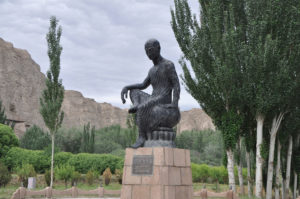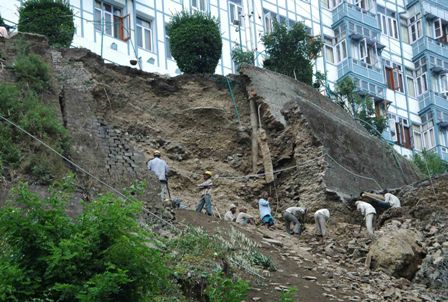Hu Shih, China’s ambassador to the US from 1938 to1942 had stated, “India conquered and dominated China culturally for 20 centuries without ever having to send a single soldier across her borders.” India’s domination included Buddhism travelling from India to Japan and Southeast Asia via China. T?dai-ji Temple in Nara, Japan has 60-feet tall bronze Buddha statue with shlokas in Sanskrit adorning its back. Hundreds visit Buddha’s Golden Temple in Seoul, South Korea every day. Buddha’s birthday is celebrated for 7-days in South Korea. Hu Shih represented Republic of China much before Mao Zhedong’s communist revolution, followed by Tibet’s annexation, its demographic invasion and cultural genocide, and killings of over a million Tibetans over past seven decades.

India’s policy towards Tibet was atrocious to begin with because of Nehru’s blind spot. Instead of supporting Tibet’s freedom, India supplied foodgrains to PLA and withdrew Indian Army posts from Tibet. Surprisingly former foreign secretary Shyam Saran defends Nehru’s policies in his book ‘How India Sees the World’. Perhaps Saran too is besotted with Beijing as Nehru was. As China became stronger, its abhorrence to Dalai Lama has forced Indian governments to fluctuate between proximity to Dalai Lama to distancing him. This ironically was despite China acting against Indian interests at every opportunity since 1962. Not that India was neglecting Buddhism but relations with Dalai Lama certainly had a depilating effect in treating Buddhism part of India’s strategic depth. The recent Chinese aggression in Ladakh should make it clear to policy makers that China’s animosity towards India will continue in the foreseeable future. India needs to boost its comprehensive national power and leverage its strategic depth.
On July 4, President Ram Nath Kovind inaugurated Dhamma Chakra Day 2020 marking the anniversary of Buddha’s First Sermon to his first five ascetic disciples at the Deer Park in present-day Sarnath in India. Dhamma Chakra Day is celebrated by the International Buddhist Confederation (IBC) under aegis of the Ministry of Culture, Government of India. Prime Minister Narendra Modi in his address said as the world fights extraordinary challenges, their lasting solutions can come from the ideals of Lord Buddha. He drew attention to the eight-fold path of Buddha showing the path towards wellbeing of societies and nations – showing respect for all, peace and non-violence. He stressed the need to connect more and more people with Buddhist heritage sites, improving connectivity to attract more people, pilgrims and tourists. Why is Buddhism part of India’s strategic depth, India being the Land of Buddha?
Strategic Depth is generally related to military operations. But classic conventional wars have been relegated to the past though not completely. But asymmetric wars are not only ongoing but are borderless and without any rules and regulations. Both conventional and asymmetric wars require enhanced application of smart power. In this backdrop, the concept of strategic depth needs to be viewed in the larger politico-military context; also factoring in sources from which strategic depth ‘draws’ strengths to dissuade enemy attacking you. Does Buddhism fit into the strategic depth of India? Yes it does, same way as it is for Tibetans who do not consider themselves part of China. Obviously, this strategic depth lies in nations following Buddhism or in countries that have sizeable population of Buddhists.
Countries with Buddhist majority population include Cambodia (97.7 percent), Thailand (94.5 percent), Myanmar (87.9 percent), Bhutan (74.7 percent), Sri Lanka (70.2 percent) and Japan (69.8 percent). China’s 18.2 percent population is Buddhist because of China occupied Tibet (COT). China’s Buddhists are mostly followers of Tibetan schools of ‘Mahayana’, making this the largest body of Buddhist traditions. ‘Mahayana’ is also practiced in majority East Asia and by over half of the world’s Buddhists. Other schools of Buddhism include ‘Theravada’ and ‘Vajrayana’. Worldwide Buddhist followers exist in over 100 countries, with over seven million Buddhism followers outside Asia.
Even a country like Spain where only 300,000 practicing Buddhists form part of the 47,370,542 Spanish population, Spain’s national court approved indictment of Hu Jintao, former Chinese President, in investigation whether the Chinese government tortured and repressed the people of Tibet as part of an attempted genocide. In December 2018, US President Donald Trump had signed into law the ‘Reciprocal Access to Tibet Act of 2018’ which promotes access for diplomats, officials, journalists and others from the United States to China’s Tibetan areas. In May 2020 US lawmaker Scott Perry introduced a bill recognizing Tibet as a separate and independent country. The bill has been sent to the White House for approval by President Trump. Presently, there are calls on social media recognize Tibet, rename Shanti Path in the Capital to Dalai Lama Marg and inviting Dalai Lama and President Tsai Ing-wen of Taiwan as Chief Guest for Republic Day 2021. These of course are policy matters to be decided by the Government of India. But we must acknowledge Buddhism is part of our strategic depth that needs to be leveraged, discounting the fear of annoying the dragon.
Prakash Katoch is third generation army officer hailing from Himachal Pradesh. He is former Lieutenant General from Special Forces and post-retirement has published over 2100 articles on international affairs, geopolitics, military, security, technical and topical issues besides authoring two books. He is active in seminars at both national and international levels.



